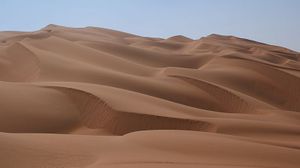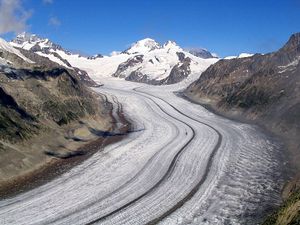Sediment

Sediment is solid material that is moved around by natural processes, like wind, water, ice, or gravity. This solid material is then deposited in a new location. This transport-and-deposition process of sediment is known as erosion. The act of breaking down monolithic material into smaller pieces is known as weathering. Weathering and erosion together are the two processes responsible for the movement of sediment across the globe. Sediment varies in size and can be as small as a grain of sand or as large as a boulder. Sediment is traditionally composed of rocks, minerals, and the remains of plants and animals.[2]
Sediment in water is generally small, and is present in nearly every body of water. When sediment in water is floating it is known as suspended sediment. Sediment that settles on the bottom of a waterway is known as bedded sediment.[3]
For a more in-depth exploration of sediment and its importance, click here.
Movement
The process of moving sediment from one place to another through a variety of different mechanisms is known as sediment transport. Transport of sediment in moderate amounts is important for diverse ecosystems to exist. The amount of sediment that can be transported is dependent upon the flow rate of the fluid, with greater amounts of sediment able to be transported at higher flow rates. [3] Another name for sediment transport is sediment load.

Air
Wind can move large volumes of sediment, and this is the main erosive force in arid environments.[5] During a dust or sandstorm, wind can move dirt across a plane. Sand dunes are created when rocky sediment is worn down by wind and the sediment is deposited in one place.[2]

Ice
Glaciers can move large sediment blocks, as rocks or debris that fall onto a glacier will be incorporated by the glacier and transported as the glacier flows under gravity. This sediment gets deposited elsewhere as the ice sheet moves across the landscape or melts. Glaciers also produce incredibly fine-grained sediment known as rock flour at their base, as sediment that is stuck onto the bottom of the glacier gets ground against the bedrock below. Sediment piles deposited along the sides and at the toes of glaciers are called moraines.[2]
Water
As rain falls on land and makes its way to the nearest river, it picks up bits of dust and other fine particulate from the land surface and transports these particles into the river. Rivers then carry this sediment all the way to the ocean where sediment is commonly deposited to form deltas. Rivers with higher flow rates can transport larger amounts of sediment. If flow is fast enough, the motion of the water can suspend particles above the riverbed as they move downstream or simply push them along the bottom of the waterway.[3]
Ecological Importance
A certain amount of sediment movement is necessary for a healthy, evolving ecosystem. The movement of sediment from one place to another enriches ecosystems with new nutrients and shapes the landscape. The supplementation of nutrients through sediment movement is important in maintaining a strong degree of biodiversity.[7]
Too much sediment in an environment can have detrimental effects[8]. The presence of too much sediment in a body of water is known as sediment pollution. Although some sediment is introduced into water through natural erosion processes, human activities such as building, bridge, and roadway construction accelerate the transport of sediment into terrestrial waterways[8]. Sediment pollution degrades water quality and clarity. Decreased water clarity can make it difficult for animals to see food beneath the surface and inhibits vegetation growth. Too much sediment in stream beds disrupts the natural food chain by destroying the habitat of extremely small stream organisms, which in turn impacts fish populations. Excess introduction of nutrients can result in harmful extreme algal blooms and eutrophication.[9]
For Further Reading
- Gas
- Hydrocarbon combustion
- Greenhouse gas
- Greenhouse effect
- Carbon capture and storage
- Or explore a random page
References
- ↑ Wikimedia Commons. (September 16, 2015). Sediment in the Gulf of Mexico [Online]. Available: https://upload.wikimedia.org/wikipedia/commons/d/d3/Sediment_in_the_Gulf_of_Mexico_(2).jpg
- ↑ 2.0 2.1 2.2 National Geographic Education. (September 12, 2015). Sediment [Online]. Available: http://education.nationalgeographic.com/encyclopedia/sediment/
- ↑ 3.0 3.1 3.2 Fundamentals of Environmental Measures. (September 16, 2016). Sediment Transport and Deposition [Online]. Available: http://www.fondriest.com/environmental-measurements/parameters/hydrology/sediment-transport-deposition/
- ↑ Wikimedia Commons. (May 27 2020). "Rub' al Khali" [Online]. Available: https://commons.wikimedia.org/wiki/File:Rub_al_Khali_002.JPG
- ↑ "Weathering and Erosional Processes in Deserts". (May 27, 2020) [Online]. Available:http://geologylearn.blogspot.com/2016/01/weathering-and-erosional-processes-in.html
- ↑ Wikimedia Commons. (May 27 2020). "Frosser Aletschgletscher" [Online]. Available: https://commons.wikimedia.org/wiki/File:Grosser_Aletschgletscher_3178.JPG
- ↑ Covich, Alan. (May 27, 2020). "The importance of sediment for biodiversity" [Online]. Accesible: https://sednet.org/download/SpecialSession4-Summary.pdf
- ↑ 8.0 8.1 Government of Canada. (May 27 2020). "Water Pollution: erosion and sedimentation" [Online]. Accessible: https://www.canada.ca/en/environment-climate-change/services/water-overview/pollution-causes-effects/erosion-sedimentation.html
- ↑ US EPA. (September 16, 2016). What is Sediment Pollution? [Online]. Available: http://cfpub.epa.gov/npstbx/files/ksmo_sediment.pdf

